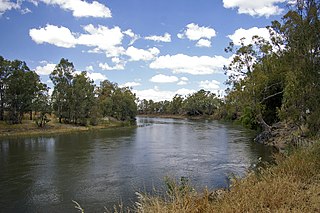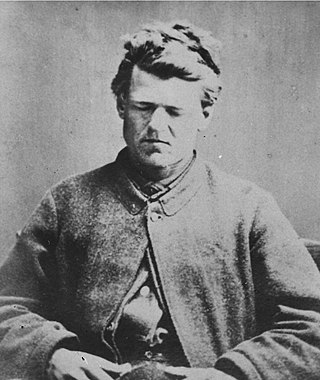
Bushrangers were originally escaped convicts in the early years of the British settlement of Australia who used the bush as a refuge to hide from the authorities. By the 1820s, the term had evolved to refer to those who took up "robbery under arms" as a way of life, using the bush as their base.

Thunderbolt is a 1910 film in the genre of "outlaw" films at the time that tended to glorify the life of the outlaw "Bushrangers" that roamed the Australian outback in pre-commonwealth days. Shortly after this film was made, the government of New South Wales banned the manufacture of this type of film on the basis that they were promoting crime.

The Murrumbidgee River is a major tributary of the Murray River within the Murray–Darling basin and the second longest river in Australia. It flows through the Australian state of New South Wales and the Australian Capital Territory, descending 1,500 metres (4,900 ft) over 1,485 kilometres (923 mi), generally in a west-northwesterly direction from the foot of Peppercorn Hill in the Fiery Range of the Snowy Mountains towards its confluence with the Murray River near Boundary Bend.

Wagga Wagga is a major regional city in the Riverina region of New South Wales, Australia. Straddling the Murrumbidgee River, with an urban population of more than 56,000 as of June 2018, Wagga Wagga is the state's largest inland city, and is an important agricultural, military, and transport hub of Australia. The ninth largest inland city in Australia, Wagga Wagga is located midway between the two largest cities in Australia—Sydney and Melbourne—and is the major regional centre for the Riverina and South West Slopes regions.

Sturt Highway is an Australian national highway in New South Wales, Victoria, and South Australia. It is an important road link for the transport of passengers and freight between Sydney and Adelaide and the regions situated adjacent to the route.

Gundagai is a town in New South Wales, Australia. Although a small town, Gundagai is a popular topic for writers and has become a representative icon of a typical Australian country town. Located along the Murrumbidgee River and Muniong, Honeysuckle, Kimo, Mooney Mooney, Murrumbidgee and Tumut mountain ranges, Gundagai is 390 kilometres (240 mi) south-west of Sydney. Until 2016, Gundagai was the administrative centre of Gundagai Shire local government area. In the 2021 census the population of Gundagai was 2,057.

The Riverina is an agricultural region of south-western New South Wales, Australia. The Riverina is distinguished from other Australian regions by the combination of flat plains, warm to hot climate and an ample supply of water for irrigation. This combination has allowed the Riverina to develop into one of the most productive and agriculturally diverse areas of Australia. Bordered on the south by the state of Victoria and on the east by the Great Dividing Range, the Riverina covers those areas of New South Wales in the Murray and Murrumbidgee drainage zones to their confluence in the west.

Urana is a small town in the Riverina region of New South Wales, Australia. The town is in the Federation Council local government area.

Daniel Morgan was an Australian bushranger. Morgan has been described as "the most bloodthirsty ruffian that ever took to the bush in Australia" and “one of the most determined and bloodthirsty of colonial freebooters”. Many accounts of his activities, particularly in the years after his death, emphasise his brutality and erratic behaviour but Morgan had many sympathisers and informants in the districts where he carried out his activities. He was an expert bushman with superb horse-riding skills, a combination of abilities which enabled him to evade capture by the authorities for a significant period of time.

Henty is a town in southwestern New South Wales close to the boundaries of the South West Slopes and the Riverina districts, almost midway between the regional cities of Albury and Wagga Wagga. At the 2006 census, Henty had a population of 863 people.
The following lists events that happened during 1905 in Australia.

Thomas Alexander Browne was an Australian author who published many of his works under the pseudonym Rolf Boldrewood. He is best known for his 1882 bushranging novel Robbery Under Arms.

Cookardinia is a rural locality in the Riverina region of New South Wales, Australia. The locality is 57 kilometres (35 mi) south of the regional city of Wagga Wagga and 24 kilometres (15 mi) east of the town of Henty. Its surrounding area has an approximate population of 283 persons.

Booroorban is a locality in the central part of the Riverina. It is in the Edward River Council local government area and on the Cobb Highway between Hay and Deniliquin, around 769 kilometres (478 mi) south west of the state capital, Sydney. At the 2016 census, Booroorban had a population of 33.
The history of Wagga Wagga details the growth of the city from a small crossing on the Murrumbidgee River to the largest city and regional centre of the Riverina region of New South Wales, Australia.

Charles Meredith was an Australian grazier and politician. He served as Tasmanian Colonial Treasurer for several years in the mid-to-late 19th century.
Joseph Michael Leary, was an Australian politician and solicitor, serving as a member of the New South Wales Legislative Assembly.

Thomas Frederick Lowry, better known as Fred Lowry, was an Australian bushranger.

Bluecap was an Australian bushranger. Born and raised in New South Wales, he began bushranging in 1867, leading a gang responsible for robberies throughout the Riverina region. He suffered from ophthalmia, and earned his alias on account of a piece of cloth he wore to protect his eyes from sunlight. Captured in November 1867, Bluecap was tried and convicted of armed robbery. He was imprisoned in Parramatta Gaol and released in 1874.
John Peisley, known informally as Jack Peisley, was an Australian bushranger who is believed to be the first bushranger born in Australia. He was a skilled bushman and horse-rider. While serving time at Cockatoo Island in the late 1850s for horse-stealing, Peisley became acquainted with Frank Gardiner. Peisley was granted a ticket-of-leave in December 1860 and soon afterwards commenced armed robberies in the Goulburn, Abercrombie, Cowra and Lambing Flat districts. He was highly mobile, riding well-bred horses and operating in districts familiar to him. Peisley’s criminal accomplices were often unnamed in newspaper reports, though Gardiner was a known associate. In December 1861 Peisley was involved in a drunken altercation, culminating in the shooting of William Benyon, who died from his wound. After his capture in January 1862 he was tried for Benyon’s murder and hanged at Bathurst in April 1862. Peisley achieved considerable notoriety within a short period and his activities and methods foreshadowed the spate of bushranging in the following years.

















